It’s a lot like the siege of Zamboanga City in September 2013 – but much worse

Block by block. House by house. Floor by floor.
The battle-tested Philippine Marines manuevered their way past Mapandi bridge in Barangay Lilod Madaya on June 9, 2017 – clearing one house and building after another until the ground suddenly shook. Molotov cocktails flew in their direction, setting troop positions on fire.
The Marines ran for safety, away from the burning houses, only to face mortar rounds fired by terrorists atop buildings. A ferocious 14-hour close quarter battle followed, killing 13 Marines on that bloody Friday.
The battle came 3 days before the government missed another self-imposed deadline to end the crisis that began on May 23. It also happened days after 11 soldiers were killed in a military airstrike gone wrong.
These incidents underscore the challenges that soldiers face in the battlefield.
Used to fighting enemies in the jungle, they found themselves drawn to urban warfare here, where young, well-armed radicals hide in multi-floored residences and establishments – sniping at will and outpacing military units not as familiar with the terrain as the terrorists are.
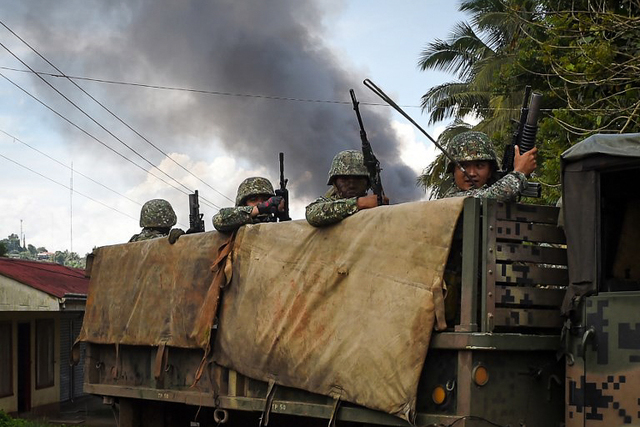
CASUALTIES OF WAR. The Marines lost 13 of their men in Marawi. File photo by Ted Aljibe/AFP
5th week of battle
On Monday, fighting continued to rage in 4 of the city's 96 villages. The military says soldiers are still hunting for a hundred terrorists who are holding about a hundred hostages including a Catholic priest.
The combined forces of the Marawi-based Maute Group and a faction of the Abu Sayyaf Group, bound by their allegiance to the international terrorist network Islamic State (ISIS), brought the war to a once-bustling city that served as the trading center of the Lanao provinces. (READ: Marawi under siege: It's like 'looking at Aleppo)
Major General Rolando Bautista, commander of the military's 1st infantry division that has jurisdiction over the Lanao provinces, said the troops were not prepared for the sniping skills of the enemy. “One sniper can paralyze the movement of a whole company, even a battalion,” he said.
Military tanks can only do so much, because the terrorists are armed with .50 caliber machine guns and rocket-propelled grenades that can pierce through metal.
Thus the tactical move to resort to airstrikes, which has caused much tension between the military and residents. "Natatakot ako sa kanila dahil wala naman pinipili 'yan eh. Ang mga targets nila is panay guesswork nila 'yun eh," said Bishop Edwin Dela Peña (Those airstrikes are not targetted, they're more guesswork). One of Dela Peña's parish priests, Father Teresito Soganub, was taken by the terrorists along with a number of church staff.

DESTRUCTION. Military airstrikes targetted buildings that terrorists used as fortifications. Screenshot of a military video
Day 1: Clash at Basak Malutlut
The clashes started at Barangay Basak Malutlut on May 23. The military raided a safe house where Isnilon Hapilon was reportedly spotted. The so-called "emir" or prince of ISIS in Southeast Asia had long been the subject of a government manhunt.
Hapilon was monitored to have left his lair in Basilan in December 2016 to join the Maute in nearby Butig, where the military was fighting the terrorists before they slipped into Marawi. (WATCH: PH flag replaces ISIS black banner at Butig town hall)
Hapilon was able to escape the May 23 raid. And what followed surprised the military. (READ: How a military raid triggered Marawi attacks)
Supporters rushed out into the streets, many waving ISIS black flags.
They seized the Amai Pakpak Medical Center, where they raised the black flag and killed a cop. (READ: He watched Maute Group kill a cop, then he escaped)
They attacked the Cathedral of Saint Mary and used a priest to reach out to the military to demand a ceasefire and allow them escape. (WATCH: A prayer for Marawi's hostaged priest)
They burned the Dansalan College, a school the Maute children used to attend, and also took its teachers hostages. They released a hundred prisoners at the Marawi City Jail.
They tried to take the city hall, too, and raise the black flag there. But Mayor Majul Gandamra stood his ground for 4 days.
"'Yung mga exhange of fires, dito naka-focus kasi yung grupo nila dito sila nag-converge kasi ang plano talaga pasukin ang City Hall. It was very fortunate [that I kept ] my focus and stayed here," Gandamra told Rappler in an interview at the City Hall on June 12. (READ: Tearful flag-raising in Marawi as PH celebrates Independence Day)
The mayor was armed to the teeth. "Mga kasamahang pamilya lang natin.... Hindi yung dami namin e. 'Yung will to fight. Kung sakaling pinasok kami talagang we will defend the city hall (I had my family with me... It's not the number of [armed men]... It's the will to fight. If they really push to take our position, we will defend the City Hall)," Gandamra said.
The terrorists also harassed the headquarters of the 103rd Brigade and the provincial capitol, located less than 2 road kilometers northwest of the city hall.
Bautista told Rappler the escalation of events confirmed intelligence information that the terrorist groups were planning to attack Marawi and establish a caliphate in this city with 90% Muslim population. According to the military, the terrorists were acting upon the instructions of ISIS leaders in the Middle East who want a refuge in Southeast Asia for their fighters, as ISIS continues to lose territory in the Middle East.
A video of Hapilon and the Maute Brothers planning an attack on the first day of Ramadan was also recovered at a safe house. (READ: AFP chief Año details aborted Maute-ISIS 'grand plan' in Marawi)
"What others termed to be a ‘botched raid’ turned out to be an ‘abortive raid’ that prevented what could have been carnage of an Islamic City in two weeks yet... This explains why at the time of the raid, the terrorist group was able to pull out–almost instantaneously and simultaneously–counter actions in various locations in the city to distract the focus of the raid," the military said on May 29.
Day 2: More troops, but enemy consolidates
On Day 2, the military brought in more troops from various parts of the country.
Instead of retreating, the terrorists consolidated in Banggolo, the financial district a few hundred meters southwest of the city hall, and nearby villages where the tallest and most fortified buildings are located.
They had ready supply of guns and ammunition, the city being notorious for loose firearms and heavily-armed clans. Escapees spoke of instances when the terrorists would simply knock on houses to ask for guns and bullets.
"Hindi lahat ng na-recover na armas ay sa Maute. 'Yung iba sa mga bahay talaga 'yun (Not all the firearms recovered belong to the Maute Group. Many of them were just found in the houses)," said a resident.
It's the worst terrain for conventional warfare.
To clear streets of terrorists, soldiers ended up boring holes into walls using sledgehammers.
There's one war in recent history that comes close to comparison: the siege of Zamboanga City in September 2013 under the Aquino government by the followers of Moro National Liberation Front (MNLF) founder Nur Misuari.
Worse than Zamboanga
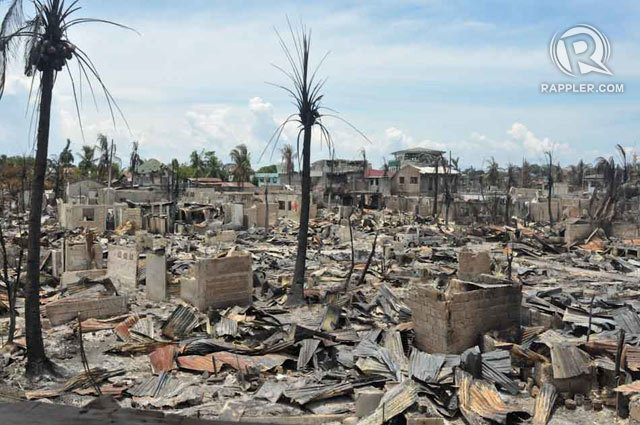
REMEMBER ZAMBOANGA? The battle zone in Zamboanga City in September 2013. File photo by LeAnne Jazul/Rappler
In Zamboanga, the enemies sailed from various parts of Mindanao and landed on 5 coastal villages where they were eventually contained. In Marawi, the enemies attacked various parts of city. And they were mostly residents themselves who grew up here.
In Zamboanga, the houses occupied by enemies were mostly made of light materials. Here, the terrorists occupied its financial district, Banggolo, where the houses are made of hardened concrete. Even airstrikes could not demolishing them.
"In the Zamboanga siege, we were clearing houses built with light materials. Here, we are clearing hardened buildings. There are even tunnels," said Western Mindanao Command chief Lieutenant General Carlito Galvez.
The siege of Zamboanga City in 2013 lasted 3 weeks, killing 19 government forces and 208 rebels, and dislocating 24,000 families.
In Marawi, 62 government forces have been killed as of June 18. This is already 3 times more than the deaths in Zamboanga. Up to 257 terrorists have been reported killed and almost all of the city’s 200,000 have been evacuated.
And it's not over yet.
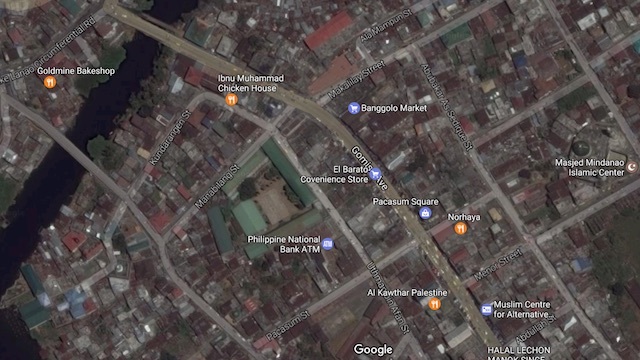
PAST THE BRIDGE, DANGER LURKS. The military announced they have the bridges entering Banggolo under control. But enemy snipers continue to prevent humanitarian workers from entering the area. Screenshot of Google Maps
The military has a specific unit that is trained to fight in urban areas, the US-trained Light Reaction Regiment (LRR), which was created in 2001 after the 9/11 terrorist attacks in America.
The elite unit is trained to either become an assaulter or a sniper – skills necessary in urban combat, hostage rescue, and neutralization of high-value targets. The military added more troops to the unit in 2014, but it's not enough for a large-scale operation such as this.
The Scout Rangers and the Marines are here to provide more muscle, but many of them had just been from months of deployment in Bohol and Sulu.
Even the Americans, despite the President's loathing toward US assistance, were seen openly operating drones here. On June 6, the military admitted the US has been providing technical assistance, as the US P3 Orion was seen flying low on the day the Marines were killed.
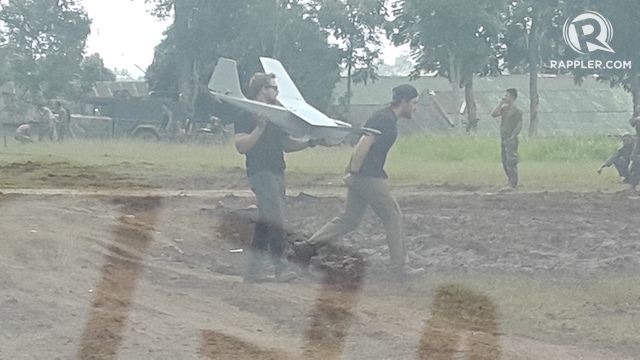
TECHNICAL ASSISTANCE. Americans were seen operating drones from the headquarters of the 103rd Brigade in Marawi. Sourced photo
A week after: Dead bodies retrieved
The war had no frontline to speak of during the first week. Journalists who were inside the brigade headquarters for a media briefing on Day 3 of the crisis witnessed how the camp was harassed.
“We prioritize large numbers of terror groups. But we are at risk with small groups who are positioned in tactical areas. Most often than not, their task is to conduct sniping operations,” Bautista said.
On Day 7, the local government started retrieving dead bodies on Basak Malutlut. It spurred hope that humanitarian work will already commence.
But enemy snipers were strategically positioned to defend the bridges that serve as the gateway to Banggolo. It would take days of airstrikes and troop advances before the military took control and pushed the terrorists to the other side of Agus River.
To this day, humanitarian workers could not cross the bridge because of the threat of enemy snipers. Rescue and retrieval are practically at a standstill.
But as hunger becomes a problem among trapped residents, local government officials have encouraged them to risk the snipers. “Either they die inside the house or they die trying to get out,” said Zia Alonto Adiong, spokesman of the provincial Crisis Management Committee.
Stray bullets from supposed sympathizers continue to reach the capitol, the city hall, and the headquarters.
A 14-year-old boy praying at a mosque was killed near the brigade headquarters while an Australian journalist survived a bullet that hit his neck while taking a video from inside the provincial capitol.
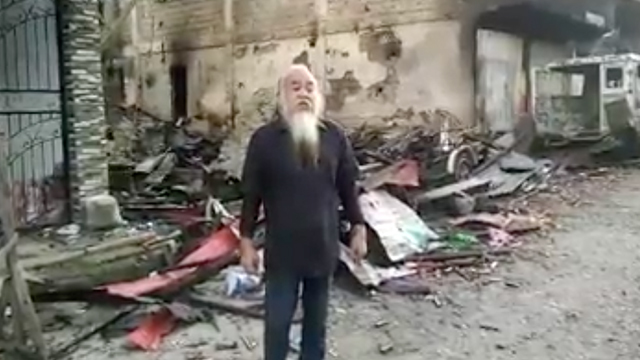
HOSTAGED. Father Teresito Suganob issues an appeal to President Rodrigo Duterte, apparently under the control of the terrorist Maute Group. Facebook screengrab
When will it end?
Outside the battle zone, authorities are running after the alleged leaders and plotters of the siege.
The parents of the Maute brothers have been arrested, and officials hope this would help weaken the group. The Maute brothers themselves have apparently been on "radio silence" mode, military sources said.
Will their continued radio silence finally lead to the silencing of the guns in the city? The trapped residents have no other wish for now.
http://www.rappler.com/newsbreak/in-depth/173050-battle-zone-marawi-urban-warfare

No comments:
Post a Comment
Note: Only a member of this blog may post a comment.